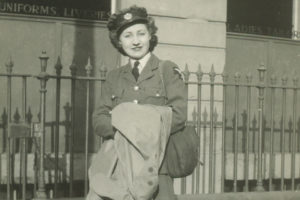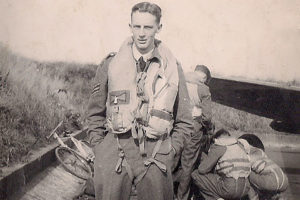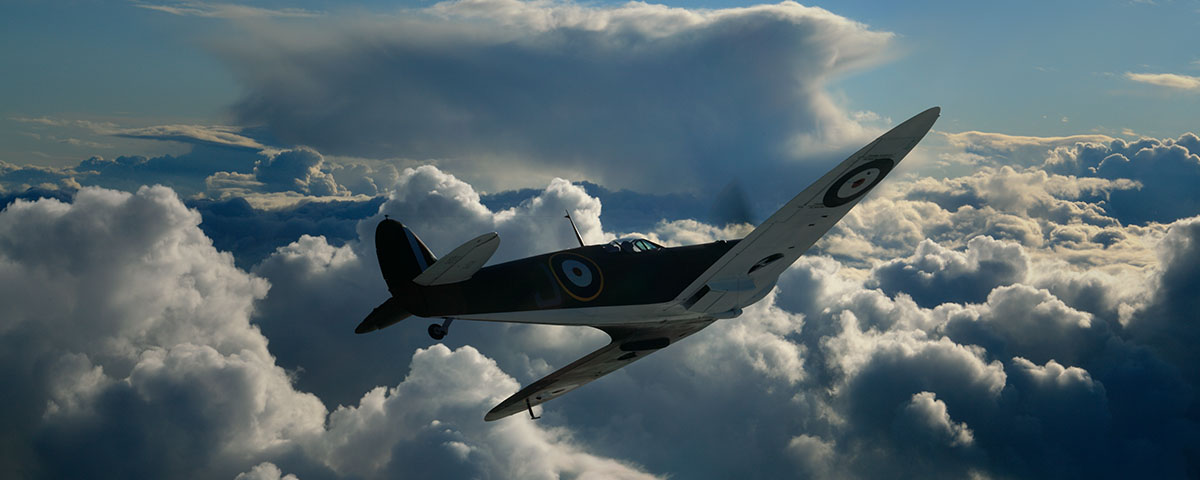The 20-year-old New Zealander had been killed 70 years earlier when his Spitfire crashed in bad weather on the border of England and Scotland. Present at the ceremony was a representative from the Royal New Zealand Air Force, members of the Air Crash Investigation and Archaeology group who discovered Robertson’s aircraft and a handful of journalists.
A Canadian woman who was in Britain on business subsequently read one of their articles. The name of the pilot rang a bell. Didn’t her mother have a boyfriend of that name during the war? She cut out the article and gave it to her mom when she returned home to Vancouver Island, Canada. Her mom blanched when she read the clipping. “Oh my!” she exclaimed. “It’s Robbo.”
Malcolm Robertson was 17 when Britain declared war on Germany in 1939. An adventurous and intelligent boy, Malcolm was the son of two teachers, and his father was a school inspector in New Zealand. Six weeks after he turned 18, Robertson volunteered for the air force, and in June 1941 began his pilot training. Within six months, he had earned his wings, been promoted to sergeant pilot and set sail for England.

Robertson arrived in February 1942 and spent several months receiving further instruction before being posted to Ouston airfield in the north of England on the last day of June. He wasn’t there long before he was transferred in October 1942 to No. 65 Squadron at RAF Drem, known in flying circles as “the coldest place on earth.”
Not that Robertson minded. He was on active duty, after all, and in Scotland, birthplace of his father before he had emigrated as a young boy to New Zealand in the late 19th century.
His only regret at leaving RAF Ouston was the parting from his sweetheart, an 18-year-old girl named Beryl Blacklett. Beryl was a WAAF, a member of the RAF Women’s Auxiliary Air Force, and she worked as a plotter in Ouston’s Fighter Command operations room. It was a crucial, demanding role, and in her free time she and her fellow WAAFs would unwind at the local pub, the Lion and Lamb.
One evening Beryl encountered a tall, slim, good-looking Spitfire pilot. His friends in the pub called him “Robbo.” He was only 20, but Sergeant Pilot Malcolm Robertson had a self-assurance beyond his years. It wasn’t arrogance—his pilot pals kept his feet on the ground—and his humor and zest for life only intensified his attractiveness in Beryl’s eyes.
He fell for her, too, this pretty young woman who had found herself thrust into a high-pressure role day after day yet coped admirably. Their parting was hard, but before Robbo left for RAF Drem they promised to write each other.
Robbo was true to his word. His first letter from Drem was chatty and casual. He’d been to the cinema the previous evening to see Abbott and Costello in Pardon My Sarong. It was so funny, he told Beryl, that “I chortled myself very dry and now have to ask others to laugh for me when a joke is cracked.”
Gradually, however, the tone of the letters changed. The relationship was becoming more serious for both of them, and Robertson was also gaining a more intimate idea of the perils of flying. “Will most likely have grey hair when you next see me,” he wrote Beryl on October 27. “Group [captain] is keen on us night-flying and we are going to do some tonight…haven’t done any since last November and none in this country. Will be very thankful when it is over and I have dropped the kite from about 50 feet onto the ground for the last time.”
Beryl and Robbo managed to meet in early November for a weekend of leave, but their reunion was brief and they were soon back at their respective airfields, separated by 100 miles. “After you left me, I wept bitter tears and Greg [a fellow pilot] led me weeping and disconsolate to the pub,” Robbo confessed in a letter.
The dashing young pilot had fallen in love, and his mounting ardor was reflected in his letters. The central theme to each was when could they next see each other? “How many times are they going to change your leave?” he complained on November 25. Then, in another (undated) letter, Robbo told Beryl that he’d just learned his

next leave would be a long one, nine whole days, from December 29 to January 7. “If you could wangle a 48 [hour leave] during that period – woo! woo! Start trying now, honey, and we’ll have fun for a little while.”
As the weather closed in, the opportunities to fly became fewer, and even when the clouds lifted there was no sign of the enemy. It was a strange time to be a fighter pilot in Britain. The Blitz had long since finished, and the Baedeker raids of spring 1942 were a distant memory. Instead, the bulk of the Luftwaffe was now engaged in two far-off theaters: Russia and North Africa.
That left Robertson and his fellow pilots of 65 Squadron with time on their hands. November 20 was what he described in a letter to Beryl as “a duff flying day,” so the squadron decided en masse to travel the 20 miles to Edinburgh, “that big bad city.” They went on a pub crawl and ended up in a snack bar, impressing the waitresses with fictional tales of bombing raids over Berlin. It worked, Robbo explained to Beryl, and in return for their “courage” they were furnished with free pastries and pies.
A fortnight later, on December 5, Robertson complained in a letter that the weather was still restricting their flying hours. “This joint is getting like an O.T.U [officer training unit],” he wrote. They had visited the operations room in Edinburgh and there “was not a thing on the board, bar a couple of convoys.” The WAAFs were as bored as the pilots.
The following week the weather improved, and 65 Squadron took to the skies in their Supermarine Spitfire Mark Vbs. First manufactured in early 1941, the Spitfire Vbs had proved their worth in March 1942 during the battle for Malta, where they outperformed the German Messerschmitt Me-109F at high altitude. Robertson’s Spitfire, AR403, had been delivered to the RAF in April 1942, and it arrived at Drem in September, three weeks before he was posted to the squadron.
During a routine patrol by 65 Squadron on the morning December 12, there was no sign of the enemy over the gray waters of the North Sea, and the pilots returned to base feeling somewhat deflated. The commander of A Flight, Roy Hewlett, was a veteran with the Distinguished Flying Cross who, although only 22, was considered one of the squadron’s “old men.” Hewlett had volunteered to test out a Spitfire that had just been repaired. As he was circling to land, Robbo wrote Beryl, “his Spit blew up in mid-air. He was a Battle of Britain man, and had done 80 sorties. Still it’s all in the luck of the game, I guess.”
There was no indication in his letters to Beryl that Hewlett’s death disturbed Robertson. He might have chosen to conceal any apprehension to his sweetheart, or he might have believed like so many young warriors that death was something that happened to others. The New Zealander, however, was upset about the postponement of his leave at the end of December. Instead he remained at Drem, writing Beryl on the 26th: “Have just come down from a dirty big scramble. As usual our sector returned whence we had come and we didn’t get a look at him [the enemy].” On the plus side, added Robertson, the view on a clear day from 14,000 feet had been spectacular, particularly the sun glinting off the lakes below. “Felt very tempted to stuff the nose down and go like a bat out of hell for them,” he confessed. “Very tempted indeed.”
Robbo’s next letter was written on January 2, the lines trembling with excitement. “Can you stand a shock?” he asked. “I am getting leave; in fact I am on it now. Have nine days.” He pleaded with Beryl to get a day or two off. She replied that she had good news and bad—the bad being that she couldn’t get any leave to coincide with Robbo’s, but the good news was she’d been given a 48-hour pass for the weekend of January 16-17, and she intended to spend it in Edinburgh.
On Saturday afternoon, January 16, Beryl telephoned her boyfriend at RAF Drem. She was connected first to the orderly room, and then, having explained the nature of her call, to the officers’ mess. She was desperate to hear Robbo’s voice, but instead she received terrible news.
For Kenny Walker, aviation archaeology began to take hold of his life in 1996, when he read a book on the subject. Now 56, the Scot has lived nearly all his life in Edinburgh, although in recent years he has traveled around much of Britain excavating crash
sites. In 2011 he visited the Heritage Center in Hawick, a Scottish market town close to the border with England, in a quest for information about another wartime air accident. Instead he stumbled upon a police report dated January 17, 1943, about the crash of a Spitfire on a hillside known locally as Hurd Law.
Intrigued, Walker delved deeper into the crash, obtaining a copy of the flying accident report, which stated the Spitfire had dived almost vertically into the ground at high speed. “There is a possibility that the pilot, on emerging from the clouds, had insufficient height at which to pull out from a high speed dive, although it is difficult to understand why the aircraft was still vertical after having had approximately 2,000 ft in which to commence pulling out.”
What captured Walker’s attention, above all, was a note in the police report indicating that the aircraft had hit the ground at such velocity that it had not been possible to extricate the wreckage on account of the depth of its resting place. Using the map reference supplied in the report, Walker contacted the Ministry of Defence and the farmer in whose field the crash occurred, and weeks later arrived with two friends from Air Crash Investigation and Archaeology (ACIA) to try to find the rest of Malcolm Robertson’s aircraft.
The three men searched the hillside but found nothing other than a spent .303 cartridge case. Then, acting on a local rumor that the crash had occurred in a field that ran down from the hillside, they widened their search. Reaching a slight indentation in the ground, which was covered in bulrushes, Walker and his companions noticed a fine film of oil. Their metal detectors were soon squawking, and one fragment retrieved from among the rushes bore a number indicating they had found Spitfire AR403.
The official excavation began in July 2012, with Walker leading a team of 18 in the recovery process. Their first finds were small, and included some of the wooden shoring used by RAF maintenance personnel when they had cleared the site to the best of their ability nearly 70 years earlier. Walker attributed a broken beer bottle and American sardine tin to these men, evidence that they ate on the job as they hurriedly attended to the crash before moving on to the next incident.
Only when they reached a depth of 18 feet did Walker and his team detect the heavy odor of petrol and then hear the clang of metal on metal as their excavator struck the remains of AR403.
Its tomb finally breached, the Spitfire now willingly gave up the rest of its secrets: the control column minus the spade grip, the compass, the lower part of the gunsight, the pilot’s rubber dinghy, his bailing out bucket, his parachute release buckle, a map case with the map still inside and part of his armored headrest.
And then, near the end of the excavation, they found the pilot himself. There wasn’t much of him, just a few bone fragments and the shredded remains of a flying uniform. It was the sight of the shoes that most affected Walker, their shoelaces still tied, as they had been by Robertson shortly before he took off at 1540 hours on January 16 for a short practice flight.
Malcolm Robertson was laid to rest on July 26, 2013, in a service conducted by an RAF chaplain. Since discovering the crash site, Kenny Walker had traced a number of Robbo’s nephews and nieces to New Zealand, one of whom, Jens Fogelberg, had visited the crash site with his wife on a vacation the previous year. Jens asked Walker to read the eulogy on the family’s behalf. “We have thought about you as we think you might have been at 1540 hours on 16th January 1943 when you powered Spitfire AR403 into cloudy skies for a one-hour practice flight,” said Walker in his address. “Our vision is that the challenge in completing your flight far overshadowed the sound of the mighty Rolls-Royce Merlin and any fleeting moments of exhilaration before you plunged through the cloud layer. Now, 70 years on, we, as your closest living relations, are grateful that we are able to think of you again today, Malcolm.”
It took Beryl a while to recover from the shock of reading about Robbo. More than 70 years had passed, and since the late 1940s she has been happily married to a British special forces soldier she met not long after the war. They’d had three children and then, in the 1950s, decided to build a new life on the other side of the world on Vancouver Island.
All the same, Robbo had been Beryl’s first love, her very own dashing fighter pilot. She still had his photographs and letters, as well as the one from his commanding officer in which his words of condolence had been smudged by the tears of the broken-
hearted young woman.
“Robbo was such fun,” recalls Beryl, now 93 and still as sharp as a tack. “He had a lovely sense of humor, and I was so smitten. I was absolutely shattered to learn of his death. It was a such a jolt to read about him after all these years. But I’m so glad they finally found him.”
Military historian Gavin Mortimer is the author of several books about World War II and aviation history. For more on Air Crash Investigation and Archaeology, visit acia.co.uk.





